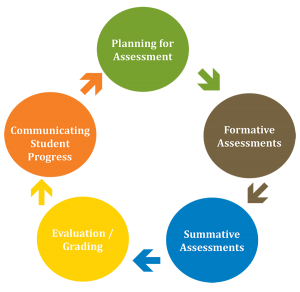
Principle #1
Assessment and evaluation practices must be aligned with essential curricular concepts, content, expectations and learning goals.
“Assessment can be seen as an effective medium for communication between the teacher and the learner. It is a way for the student to communicate their learning to their teacher and for the teacher to communicate back to the student a commentary on their learning.”
—p.7, Liljedahl, 2010
Although assessment and evaluation are often thought to be interchangeable, they are not in fact the same. While assessment tends to be formative in nature, ongoing and designed to enhance learning, evaluation is summative in nature and often focuses on the final product, making a judgement about the student’s level of understanding. Each of these plays a significant role in classroom instruction.
To ensure assessment and evaluation align with the curricular competencies and learning goals, teachers need to, from the onset, decide what the key concepts are, plan the assessments and then plan lessons that allow students to demonstrate their learning. When teachers and students share established goals for learning the effect size is .058! (See Hattie’s list of factors.) Clearly communicated goal setting drives learning and achievement (Locke and Latham, 2002).
To assist teachers with this process, the North Vancouver School District has embraced the backward design framework Understanding by Design or UbD (Wiggins & McTighe, 2005) to plan instruction and to ensure assessment practices are aligned with the overarching unit goals. Assessments enhance learning when the end learning goals, assessments and assessment criteria are known in advance. Backward design provides students and teachers with a direct path to understanding the important ideas of the unit and allows them to transfer their learning to new situations.
ASSESSMENT CYCLE

TRY THIS
Click here for ideas to try in the classroom
1) Use a Unit Planner on the Curriculum Hub.
2) Create a list of the competencies you are targeting in your lessons.
3) Ask yourself: What is essential for your students to know?
4) Write the learning targets of the lesson on the board every day.
• Think of a learning target as the GPS of your lesson!
6) Ask yourself: In five years, what do you want your students to remember from your class?
7) Ensure all lessons serve a purpose in a longer learning trajectory towards the learning goal. It is not a learning target unless both the teacher and students aim for it during the lessons.
8) Set and commit to specific, appropriate, and challenging goals which leads to increased student achievement and motivation to learn.
9) Use real-world/authentic performances as part of your assessment.
10) Authentic tasks can be created based on McTighe & Wiggins GRASPS tasks.
11) Use the NVSD yearly planner to ensure your assessments are aligned with all of your Big Ideas, Curricular Competencies and content.
12) Use the Planners that have been developed using the UbD model of Wiggins and McTighe (2005). They act as a guide using the foundational principles of the backwards design process.
WATCH THIS
Click here to watch related video content
What is Understanding by Design? Author Jay McTighe explains
Understanding by Design (UbD) is a framework for improving student achievement. Emphasising the teacher’s critical role as a designer of student learning, UbD™ works within the standards-driven curriculum to help teachers clarify learning goals, devise revealing assessments of student understanding, and craft effective and engaging learning activities.
Grant Wiggins – Understanding by Design
Educator Grant Wiggins leads a workshop at Avenues on Understanding by Design (UbD), a framework for improving student achievement that helps teachers clarify learning goals, devise assessments that reveal student understanding, and craft effective learning activities.
Creating Authentic Assessments Webinar
Authentic assessments require the transfer of knowledge and skills into real-world situations to both measure and motivate student learning. When students are bored with the work they are asked to do, they superficially read texts, casually execute procedures, and cursorily explain their thinking. This detachment makes it increasingly difficult for students to retain learning after the lesson, unit, or year is over and harder for teachers to improve student performance.
BC’s K-12 Assessment System
Assessment and curriculum are interconnected. Curriculum sets the learning standards that give focus to classroom instruction and assessment. Assessment involves the wide variety of methods or tools that educators use to identify student learning needs, measure competency acquisition, and evaluate students’ progress toward meeting provincial learning standards. Learn more.
READ THIS
Click here for additional reading suggestions
To learn more, check out these texts:
- Airasian, P., Engemann, J., Gallagher, T. (2012). Classroom Assessment Concepts and Applications. McGraw-Hill, Columbus, OH.
- Chappuis, J. & Chappuis, S. (2002). Understanding School Assessment. Assessment Training Institute, Portland, OR.
- Liljedahl, P. (2010). The four purposes of assessment. Vector, 2010(2), 4-12.
- Moss, C.M, & Brookhart. S.M. (2012). Learning Targets, ASCD, Alexandria, VA.
- Wiggins, G. (1998). Educative assessment: Designing assessments to inform and improve student performance. San Francisco, CA: Jossey-Bass.
- Wiggins, G., & McTighe, J. (2005). Understanding by Design (expanded 2nd edition). Alexandria, VA: ASCD.
- Wiggins, G., & McTighe, J. (2011). The Understanding by Design guide to creating high quality units. Alexandria, VA: ASCD.
